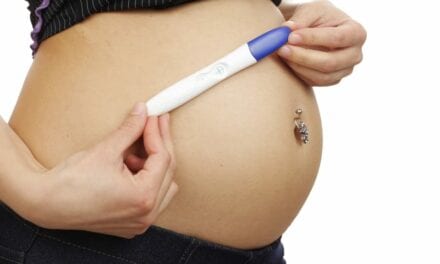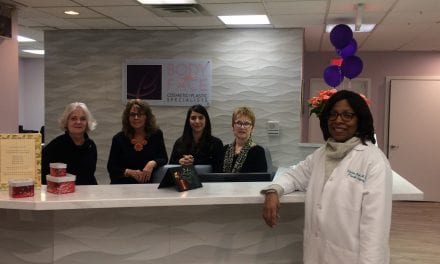
Before and 1 month after a Total Mommy Makeover in a 35-year-old, 5-foot-5-inch, 55-pound mother of three.
During the past 5 or so years, an extraordinary new social phenomenon has occurred in plastic surgeons’ offices across the country. Middle-aged mothers are having their sagging breasts enhanced, their loose tummies tightened, and any excess waist fat liposuctioned away. This combination of upper- and lower-body contouring procedures is being performed to reverse the natural body changes that follow pregnancy, breast-feeding, and motherhood.
Plastic surgeons often describe this combination of procedures as the “mommy makeover,” a term that currently has more than 1,600,000 citations on Google. It’s not quite as popular in the medical literature. In fact, a search in the Journal of Plastic and Reconstructive Surgery yielded no hits during the past 10 years.
“Mommy makeover” is a concept and a catchy catchphrase that resonates with women who have completed their childbearing years. That said, the individual procedures have long been provided, and the technology is not new. Instead, the standard techniques have been refined so that they can be performed in one or two operations.
Ten years ago, combining and integrating separate body-contouring operations was a new and radical approach that I helped pioneer.1 But times have changed. Today, refinements in technique and added safety measures have allowed numerous plastic surgeons to respond to the demand. The last 7 years have been devoted to improving body-contouring outcomes in all of our patients through better patient selection and preparation, the use of new techniques and technology, and refinements in postoperative care.2
MARKETING MOMMY MAKEOVERS: THE CONTROVERSY
The appropriateness and marketing of extensive body-altering surgery to treat the aftermath of childbearing and motherhood is controversial. When mommy makeover had become a well-recognized surgical offering in 2007, The New York Times implied that plastic surgeons who offer these makeovers are preying on the vulnerabilities of a large population of women.3 If indeed they request a tummy tuck, the plastic surgeon will up-sell them additional surgery in the form of a breast-reshaping operation, The New York Times alleged.
This does not seem to be the case.
During the past decade, it has become socially acceptable for women to request and undergo cosmetic operations that reverse the changes associated with pregnancy. Today’s mothers often ask friends or search the Internet to find an appropriate surgeon with experience performing mommy makeovers. Most commonly, these operations are breast augmentation with implants, mastopexy, abdominoplasty, and liposuction. Furthermore, today’s savvy moms are aware that several procedures can safely be done at once.
The numbers speak to the demand and desire for these postpregnancy procedures. While mommy makeover is not listed per se, the 2011 procedural statistics released by the American Society for Aesthetic Plastic Surgery (ASAPS) lists the greatest increase in the separate operations that constitute a mommy makeover. Among the most popular operations performed on women, four of the five are part of every mommy makeover, and each experienced an incredible growth in the past 15 years. Since 1997, when ASAPS first started tracking procedure numbers and trends and there was no concept of a mommy makeover, there has been a 208% increase in women’s surgery overall. There was a 539% increase in mastopexy and a more than 339% uptick in abdominoplasty during this same time frame.4
The 2011 American Society of Plastic Surgeon (ASPS) statistics back up these trends.5 There were 115,902 abdominoplasties in 2011, compared with 62,713 in 2000, representing an 85% increase. There were 90,679 mastopexies in 2011, which is a 27% increase over 2000. Breast augmentation increased 45% during the same time frame.
MOMMY MAKEOVER VERSUS TOTAL BODY LIFT
Predating the onset of the mommy makeover era, I was implementing new operations and their combinations for the rehabilitation of the massive-weight-loss patient.1 My thesis was that comprehensive and coordinated aesthetic reconstruction after major skin laxity and contour changes can, and should, be performed in as few stages as is safely possible to boost patient satisfaction and self-esteem.

Before and 1 year after photos of a Total Mommy Makeover in a 31-year-old, 5-foot-6-inch, 150-pound mother of two. Partial Front view.
For example, the patient may appreciate her abdominoplasty, but still have low self-esteem and not wear revealing clothing if her thighs remained unacceptable to her. We also embraced team surgery in which a consistent group of experienced multiple operators and assistants work together.
Single-stage total body lift is best performed in those physically and mentally fit who are under the age of 50 and highly motivated. After massive weight loss, they are willing to accept a 65% rate of wound-healing complications.6 In general, the skin and contour change after pregnancy is not nearly as severe; hence, the tolerance for complications is less. Furthermore, the 3 to 5 days of in-hospital care required by the massive-weight-loss patient is unlikely to be acceptable to many moms. While 8 hours of operative time is common for the massive-weight-loss patient, we rarely exceed 5 in the postpregnancy mommy makeover patient.
ANATOMY OF A MOMMY MAKEOVER
There is no stereotypical mommy makeover patient. The common denominator between all of them seem to be that they are unwilling to accept the physical changes they witnessed in their own mothers.
We most often perform isolated breast augmentation with or without mastopexy and isolated abdominoplasty. However, many multiparous mothers want correction of their entire torso. If they are healthy, fit, young, not obese, and motivated, we perform a single stage.
Thorough preparation and aftercare are important. To assist in the education of our patients, I wrote a book of instructions that is loaded with testimonials.7 Relevant social and nutritional history is taken and coupled with a general physical examination and a battery of micro-nutrients, elements, hematology, and chemistries.8 All patients receive a powdered supplement of ProCare MD from NutriEssential modified to our specifications. It contains trace elements, proteins, and amino acids much needed for extensive wound healing.9

Preoperative drawings of a Total Mommy Makeover patient.
Immediately preop, the surgical planning and marking of incision lines is made with alcohol-resistant ink markings. Viscot markers leave a consistent thickness line, have more than adequate ink, and image after the new alcohol-based preps have dried.
For a Total Mommy Makeover, surgical planning starts with the breast. The initial examination includes measurements of breast to chest wall distances and base width. Asymmetry, tissue fullness, and elasticity are factored. Examination and breast manipulation continue in front of a mirror.
AxisThree 3D surface scans with virtual implant augmentation are very helpful in presenting the true appearance and then simulating precise changes after specific implant augmentation in either the subpectoral or submammary planes. The nipple-areolar complexes can be raised as needed, demonstrating the change of mastopexy. There are advantages and trade-offs of limited scar mastopexies that are weighed. Then different-sized gel implants are placed in a surgical bra, starting with the best size on the 3D Scanner.
Ultimately, there is agreement on the implant size, projection, and relationship to the pectoris muscle. The surgical markings reflect those decisions as well as the relocation of the nipple and excess skin to be excised.
The patient is marked for an elliptical removal of the skin between the umbilicus and pubis, a circular cutout umbilicoplasty, and areas of nearby trunk liposuction. After excess fat is suctioned from the upper abdominal flap, it is undermined in the midline only. Weakness along the midline is imbricated with a running stitch of #2 PDO Quill. The excess skin is removed from the lower abdomen. Then the upper flap is sutured to the pubic area and groins, while a pull-through central high-tension umbilicoplasty is performed.

Before and 1 year after photos of a Total Mommy Makeover in a 31-year-old, 5-foot-6-inch, 150-pound mother of two. Side view.

Before and 1 year after photos of a Total Mommy Makeover in a 31-year-old, 5-foot-6-inch, 150-pound mother of two. Frontal views.
The patient is placed in an abdominal binder and a surgical bra. Immediate postoperative care is focused fluid management and pain control. For in-patients, there is intravenous patient-controlled analgesia. For outpatients, oral narcotic tablets usually are sufficient. After recovery and instructions on wound and drain care, the patient is discharged. Within a week, endermologie is started and drains are removed. Soon afterward, edema is managed with elastic garments, Hivamat electrophysiologic massage, lymphatic drainage, and pressure pumps.
Patients understand that while a body-contour improvement is expected, the precise change is unpredictable. Should expectations be unmet or complications ensue, the patient may need to undergo additional procedures with limited charges.
As we continue to perfect our surgical techniques and technology improves even further, we will likely see growing numbers of women embrace the mommy makeover.
Dennis J. Hurwitz, MD, is the director of the Hurwitz Center for Plastic Surgery in Pittsburgh. He specializes in body contouring, facelift, rhinoplasty, and cleft lip repair. Hurwitz is a clinical professor of surgery at the University of Pittsburgh. A member of the American Society for Aesthetic Plastic Surgery, the American Society of Plastic Surgeons, and the American Association of Plastic Surgeons, he is certified by the American Boards of Plastic Surgery and Board of Surgery. He can be reached via [email protected].
REFERENCES
- Hurwitz DJ. Single stage total body lift after massive weight loss. Ann Plast Surg. 2004;52:5:435-441.
- Veitia N, Hurwitz DJ. Total body lift after massive weight loss. In: Shiffman MA, Di Giuseppe A, eds. Body Contouring: Art, Science and Clinical Practice. Springer-Verlag Berlin Heidelberg; 2010:695-708.
- Singer N. The New York Times. October 4, 2007.
- Author’s search of www.surgery.org, March 22, 2012.
- Author’s search of HYPERLINK “www.plasticsurgery.org” www.plasticsurgery.org, March 22,2012.
- Hurwitz DJ, Agha-Mohammadi S, Ota K, Unadkat J. A clinical review of total body lift. Aesth Surg J. 2008;28:3:294-304.
- Hurwitz DJ. Total Body Lift: Reshaping the Breasts, Chest, Arms, Thighs, Hips, Back, Waist, Abdomen, and Knees After Weight Loss, Aging, and Pregnancies. New York, NY: MDPublish; 2005.
- Agha-Mohammadi S, Hurwitz DJ. Nutritional deficiency of post-bariatric body contouring patients: What every plastic surgeon should know. Plast Reconstr Surg. 2008;122(2):604-613.
- Agha-Mohammadi S, Hurwitz DJ. Potential impacts of nutritional deficiency of post-bariatric patients on body contouring. Plast Reconstr Surg. 2008;122(6):1901-1914.




